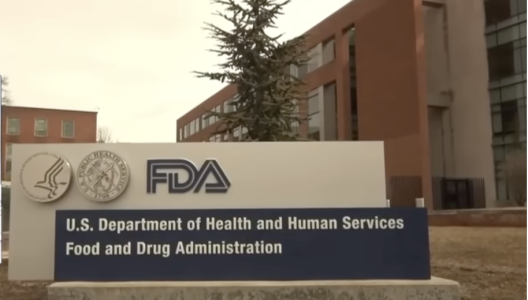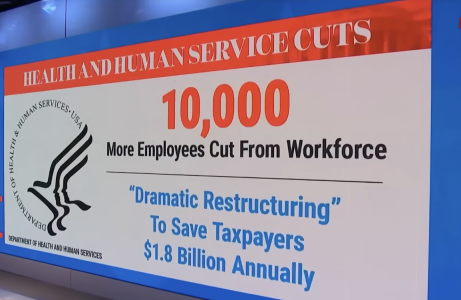What’s next for federal health programs? Proposed cuts raise questions
- Replies 0
A major shake-up is underway in one of the nation’s largest federal departments—one that could reshape how key health services are managed across the country.
The sweeping plan promises efficiency and cost-cutting, but also comes with big changes to the size and structure of the workforce.
What this could mean for the future of public health programs remains to be seen.
In a move that has sent shockwaves through the healthcare community, the Trump administration has announced a sweeping reorganization of the Department of Health and Human Services (HHS), which will result in a significant reduction of its workforce.
The plan, which aims to streamline operations and cut costs, will see the department's employee count shrink by nearly 20,000—a 33% decrease from its size at the end of the Biden administration. The department had around 92,620 employees in September 2024, up from 81,917 at the last leg of the previous Trump administration.
The HHS is a cornerstone of the American healthcare system, overseeing a broad range of critical services from the Food and Drug Administration (FDA) to the Centers for Disease Control and Prevention (CDC).
The proposed cuts raise concerns about how these changes might affect the quality and accessibility of healthcare services for millions of Americans, particularly those in the over-60 demographic who often rely heavily on these services.

The restructuring plan includes the elimination of 10,000 full-time positions through layoffs, with additional vacant roles going unfilled. This follows a trend of thousands of staff departures and the removal of contractor and fellowship positions in recent months.
The HHS estimates that these changes will save taxpayers approximately $1.8 billion. “When combined with HHS' other efforts, including early retirement and Fork in the Road, the restructuring results in a total downsizing from 82,000 to 62,000 full-time employees.”
A fact sheet provided to reporters and senior health official share that “no additional cuts are currently planned” beyond those announced on Thursday and in recent weeks.
Specifically, the FDA will lose 3,500 jobs, the National Institutes of Health will see a reduction of 1,200 positions, and the CDC will downsize by about 2,400 employees to “focus on returning to its core mission of preparing for and respond to epidemics and outbreaks.”
"This reduction will not affect drug, medical device, or food reviewers, nor will it impact inspectors," the fact sheet says of the FDA changes.
The Centers for Medicare and Medicaid Services (CMS) will also experience a workforce decline of roughly 300 employees “with a focus on reducing minor duplication.” Despite these cuts, the administration assures that critical roles such as drug, medical device, and food reviewers, as well as inspectors, will not be affected.
The reduction-in-force is said to be “primarily aimed at administrative positions,” as per the letter sent Thursday to unions in multiple HHS agencies. It will also “target roles in high-cost regions” and who are "determined to be redundant or duplicative" with others.
"The entire federal workforce is downsizing now. So this will be a painful period for HHS," Kennedy said in video annoncement shared Thursday by the department.
A new vision for HHS: The administration for a healthy America
Amidst the reductions, HHS Secretary Robert F. Kennedy has proposed the creation of a new entity within the department: the Administration for a Healthy America (AHA). This consolidation aims to eliminate what the administration views as bureaucratic redundancies by merging several existing agencies and offices into a unified organization.
"We are with Elon's help eliminating the redundancies." Kennedy said. "We're going to imbue the agency with a clear sense of mission to radically improve the health of Americans and to improve agency morale. We're going to eliminate an entire alphabet soup of departments and agencies while preserving their core functions."
The AHA will absorb functions from the Office of the Assistant Secretary for Health, Health Resources and Services Administration, Substance Abuse and Mental Health Services Administration, Agency for Toxic Substances and Disease Registry, and National Institute for Occupational Safety and Health.
The Administration for Strategic Preparedness and Response will be integrated into the CDC, and the Agency for Healthcare Research and Quality will merge with another agency to form the Office of Strategy.
Health officials have been preparing for the steep cuts to be announced, as part of the restructuring planned with the Department of Government Efficiency (DOGE). One major change that was announced earlier this month was the significant decrease in the number of general counsel offices, lowering the ranks of the department’s attorneys by two-thirds, allegedly.

The human cost of downsizing
The announcement has understandably caused anxiety among HHS employees, many of whom are facing uncertainty about their job security.
The department's reduction-in-force targets administrative positions and roles in high-cost regions deemed redundant or duplicative. Notices to affected employees may have already been sent, marking the beginning of a challenging transition period for the department.
Source: Face the Nation / Youtube.
Details of who exactly will be removed from the department within the agencies remain uncertain, under the new reorganization plans. Kennedy said that they were "focused on paring away excess administrators while increasing the number of scientists and frontline health providers" in the changes.
"We're going to streamline our agency and eliminate redundancies and invite everyone to align behind a simple, bold mission: I want every HHS employee to wake up every morning asking themselves, 'what can I do to restore American health today,'" he shared.

Have you or a loved one been directly affected by the HHS workforce reductions? Are you concerned about how these changes might impact your access to healthcare services? Join the conversation in the comments below!
The sweeping plan promises efficiency and cost-cutting, but also comes with big changes to the size and structure of the workforce.
What this could mean for the future of public health programs remains to be seen.
In a move that has sent shockwaves through the healthcare community, the Trump administration has announced a sweeping reorganization of the Department of Health and Human Services (HHS), which will result in a significant reduction of its workforce.
The plan, which aims to streamline operations and cut costs, will see the department's employee count shrink by nearly 20,000—a 33% decrease from its size at the end of the Biden administration. The department had around 92,620 employees in September 2024, up from 81,917 at the last leg of the previous Trump administration.
The HHS is a cornerstone of the American healthcare system, overseeing a broad range of critical services from the Food and Drug Administration (FDA) to the Centers for Disease Control and Prevention (CDC).
The proposed cuts raise concerns about how these changes might affect the quality and accessibility of healthcare services for millions of Americans, particularly those in the over-60 demographic who often rely heavily on these services.

The Trump administration is executing a major restructuring to reduce the workforce of the Department of Health and Human Services by nearly 25%. Image source: NBC News / Youtube.
The restructuring plan includes the elimination of 10,000 full-time positions through layoffs, with additional vacant roles going unfilled. This follows a trend of thousands of staff departures and the removal of contractor and fellowship positions in recent months.
The HHS estimates that these changes will save taxpayers approximately $1.8 billion. “When combined with HHS' other efforts, including early retirement and Fork in the Road, the restructuring results in a total downsizing from 82,000 to 62,000 full-time employees.”
A fact sheet provided to reporters and senior health official share that “no additional cuts are currently planned” beyond those announced on Thursday and in recent weeks.
Specifically, the FDA will lose 3,500 jobs, the National Institutes of Health will see a reduction of 1,200 positions, and the CDC will downsize by about 2,400 employees to “focus on returning to its core mission of preparing for and respond to epidemics and outbreaks.”
"This reduction will not affect drug, medical device, or food reviewers, nor will it impact inspectors," the fact sheet says of the FDA changes.
The Centers for Medicare and Medicaid Services (CMS) will also experience a workforce decline of roughly 300 employees “with a focus on reducing minor duplication.” Despite these cuts, the administration assures that critical roles such as drug, medical device, and food reviewers, as well as inspectors, will not be affected.
The reduction-in-force is said to be “primarily aimed at administrative positions,” as per the letter sent Thursday to unions in multiple HHS agencies. It will also “target roles in high-cost regions” and who are "determined to be redundant or duplicative" with others.
"The entire federal workforce is downsizing now. So this will be a painful period for HHS," Kennedy said in video annoncement shared Thursday by the department.
A new vision for HHS: The administration for a healthy America
Amidst the reductions, HHS Secretary Robert F. Kennedy has proposed the creation of a new entity within the department: the Administration for a Healthy America (AHA). This consolidation aims to eliminate what the administration views as bureaucratic redundancies by merging several existing agencies and offices into a unified organization.
"We are with Elon's help eliminating the redundancies." Kennedy said. "We're going to imbue the agency with a clear sense of mission to radically improve the health of Americans and to improve agency morale. We're going to eliminate an entire alphabet soup of departments and agencies while preserving their core functions."
The AHA will absorb functions from the Office of the Assistant Secretary for Health, Health Resources and Services Administration, Substance Abuse and Mental Health Services Administration, Agency for Toxic Substances and Disease Registry, and National Institute for Occupational Safety and Health.
The Administration for Strategic Preparedness and Response will be integrated into the CDC, and the Agency for Healthcare Research and Quality will merge with another agency to form the Office of Strategy.
Health officials have been preparing for the steep cuts to be announced, as part of the restructuring planned with the Department of Government Efficiency (DOGE). One major change that was announced earlier this month was the significant decrease in the number of general counsel offices, lowering the ranks of the department’s attorneys by two-thirds, allegedly.

Approximately 10,000 full-time employees will be laid off, with additional positions remaining vacant and not replaced. Image source: Face the Nation / Youtube.
The human cost of downsizing
The announcement has understandably caused anxiety among HHS employees, many of whom are facing uncertainty about their job security.
The department's reduction-in-force targets administrative positions and roles in high-cost regions deemed redundant or duplicative. Notices to affected employees may have already been sent, marking the beginning of a challenging transition period for the department.
Source: Face the Nation / Youtube.
Details of who exactly will be removed from the department within the agencies remain uncertain, under the new reorganization plans. Kennedy said that they were "focused on paring away excess administrators while increasing the number of scientists and frontline health providers" in the changes.
"We're going to streamline our agency and eliminate redundancies and invite everyone to align behind a simple, bold mission: I want every HHS employee to wake up every morning asking themselves, 'what can I do to restore American health today,'" he shared.
Key Takeaways
- The Trump administration is executing a major restructuring to reduce the workforce of the Department of Health and Human Services by nearly 33%, resulting in a department size one-third smaller than under the previous Biden administration.
- Approximately 10,000 full-time employees will be laid off, with additional positions remaining vacant and not replaced. The administration claims this will save taxpayers $1.8 billion.
- Significant job cuts will occur across several sub-agencies, including 3,500 from the Food and Drug Administration, 1,200 from the National Institutes of Health, and around 2,400 from the Centers for Disease Control and Prevention. However, these are claimed not to affect critical roles such as drug reviewers or inspectors.
- A major proposed change under Health and Human Services Secretary Robert F. Kennedy is the creation of the Administration for a Healthy America (AHA), consolidating several existing agencies and aligning with the 'Make America Healthy Again' priorities to improve efficiency and service quality.
Have you or a loved one been directly affected by the HHS workforce reductions? Are you concerned about how these changes might impact your access to healthcare services? Join the conversation in the comments below!







